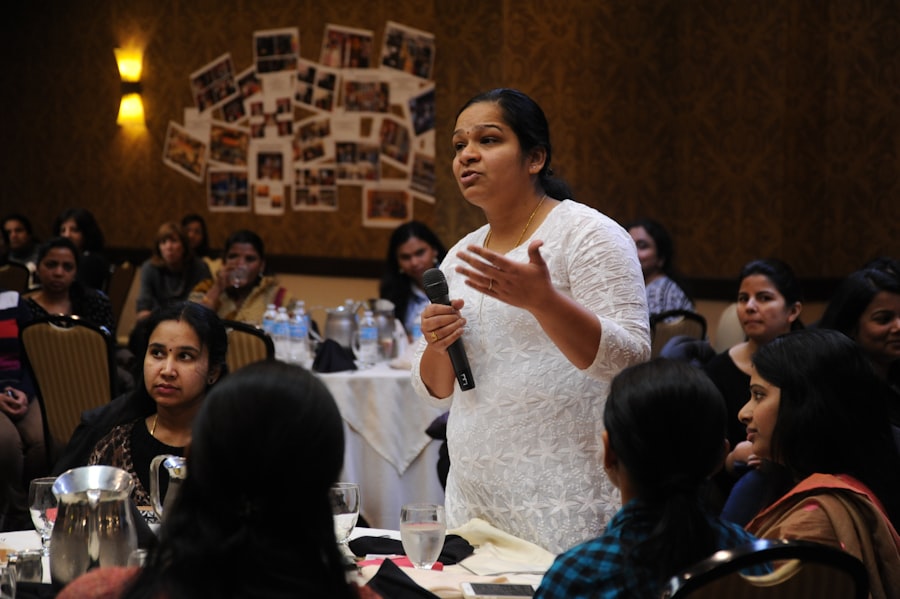Social science plays a pivotal role in education, serving as a bridge between the individual and the broader societal context. It encompasses various disciplines, including sociology, psychology, anthropology, economics, and political science, all of which contribute to a comprehensive understanding of human behavior and societal structures.
This understanding is crucial for fostering informed citizens who can engage thoughtfully with contemporary issues. Moreover, social science education cultivates critical thinking and analytical skills. Students learn to evaluate evidence, consider multiple perspectives, and understand the implications of their decisions within a societal framework.
This skill set is not only essential for academic success but also for personal development and civic engagement. In an increasingly interconnected world, where global challenges such as climate change, inequality, and political unrest are prevalent, the ability to analyze and respond to these issues through a social science lens becomes indispensable.
Key Takeaways
- Social science education is important for developing critical thinking, problem-solving, and decision-making skills in students.
- Strategies for integrating social science into the curriculum include interdisciplinary approaches, project-based learning, and real-world applications.
- Integrating social science into the curriculum benefits students by promoting cultural awareness, empathy, and understanding of societal issues.
- Challenges of integrating social science into the curriculum include limited resources, standardized testing pressures, and resistance to change.
- Successful integration of social science into the curriculum can be seen in schools that prioritize experiential learning, community partnerships, and teacher professional development.
Strategies for Integrating Social Science into Curriculum
Integrating social science into the curriculum requires thoughtful planning and innovative approaches that resonate with students’ interests and experiences. One effective strategy is project-based learning, where students engage in real-world problems that require them to apply social science concepts. For instance, a project could involve researching local community issues, such as housing inequality or access to education, allowing students to connect theoretical knowledge with practical applications.
This hands-on approach not only enhances engagement but also fosters a sense of agency among students as they explore solutions to pressing societal challenges. Another strategy involves interdisciplinary collaboration, where educators from different subject areas work together to create cohesive learning experiences. For example, a history teacher might collaborate with a science teacher to explore the social implications of environmental policies throughout history.
By weaving together narratives from different disciplines, students can develop a more nuanced understanding of how social dynamics influence scientific advancements and vice versa. This approach encourages students to draw connections between various fields of study, promoting holistic learning.
Benefits of Integrating Social Science into Curriculum

The integration of social science into the curriculum offers numerous benefits that extend beyond academic achievement. One significant advantage is the enhancement of students’ social awareness and empathy. By studying diverse cultures, historical events, and social movements, students develop a deeper appreciation for the complexities of human experiences.
This exposure fosters empathy and understanding, equipping students with the emotional intelligence necessary to navigate an increasingly diverse society. Additionally, integrating social science promotes civic engagement among students. As they learn about governance, rights, and responsibilities, they become more informed citizens who are better prepared to participate in democratic processes.
This engagement can manifest in various forms, from voting to community service or advocacy work.
Challenges of Integrating Social Science into Curriculum
| Challenges | Description |
|---|---|
| Lack of resources | Insufficient funding for social science curriculum development and implementation. |
| Resistance to change | Resistance from traditional curriculum stakeholders to integrate social science into existing curriculum. |
| Interdisciplinary coordination | Difficulty in coordinating social science with other disciplines in the curriculum. |
| Ethical considerations | Challenges in addressing sensitive social issues and ethical considerations in the curriculum. |
Despite its numerous benefits, integrating social science into the curriculum is not without challenges. One significant hurdle is the perception that social sciences are less rigorous than other academic disciplines such as mathematics or the natural sciences. This misconception can lead to a lack of support for social science programs within educational institutions and among policymakers.
Educators may find it difficult to secure funding or resources necessary for effective implementation, which can hinder the development of comprehensive social science curricula. Another challenge lies in the need for professional development among educators. Many teachers may not feel adequately prepared to teach social science subjects or integrate them effectively into their existing curricula.
This gap in training can result in a superficial treatment of social science topics or an over-reliance on outdated teaching methods. To address this issue, ongoing professional development opportunities must be provided to equip educators with the knowledge and skills needed to teach social science effectively.
Examples of Successful Integration of Social Science into Curriculum
Several educational institutions have successfully integrated social science into their curricula, serving as models for others to follow. One notable example is the High School for Environmental Studies in New York City, which incorporates environmental science with social studies to explore issues such as climate change and urban development. Students engage in fieldwork and community projects that allow them to apply their learning in real-world contexts while examining the social implications of environmental policies.
Another exemplary case is the International Baccalaureate (IB) program, which emphasizes interdisciplinary learning across subjects. The IB curriculum encourages students to explore global issues through various lenses, including economics, history, and geography. This approach not only enriches students’ understanding of complex topics but also prepares them for higher education and global citizenship by fostering critical thinking and intercultural understanding.
Impact of Integrating Social Science into Curriculum on Student Learning

The impact of integrating social science into the curriculum on student learning is profound and multifaceted. Research has shown that students who engage with social science content demonstrate improved critical thinking skills and a greater ability to analyze complex issues. For instance, studies indicate that students exposed to project-based learning in social sciences exhibit higher levels of engagement and retention compared to those who experience traditional lecture-based instruction.
Furthermore, integrating social science fosters collaboration among students as they work together on projects or discussions related to societal issues. This collaborative environment not only enhances communication skills but also encourages diverse viewpoints and respectful discourse. As students learn to navigate differing opinions and work towards common goals, they develop essential skills that are applicable both in academic settings and in their future careers.
Resources for Integrating Social Science into Curriculum
A wealth of resources is available for educators seeking to integrate social science into their curricula effectively. Professional organizations such as the National Council for the Social Studies (NCSS) provide guidelines, lesson plans, and professional development opportunities tailored specifically for social science educators. These resources can help teachers stay current with best practices and innovative teaching strategies.
Additionally, online platforms such as Teaching Tolerance offer free educational materials focused on diversity, equity, and inclusion within social studies education. These resources include lesson plans, multimedia content, and activities designed to engage students in meaningful discussions about social justice issues. By leveraging these resources, educators can create dynamic learning environments that promote critical thinking and foster an appreciation for diverse perspectives.
Future Trends in Integrating Social Science into Curriculum
As education continues to evolve in response to societal changes, several trends are emerging in the integration of social science into curricula. One notable trend is the increasing emphasis on technology-enhanced learning experiences. Digital tools such as virtual reality (VR) and augmented reality (AR) are being utilized to create immersive learning environments where students can explore historical events or cultural practices firsthand.
These technologies offer unique opportunities for experiential learning that can deepen students’ understanding of complex social issues. Another trend is the growing focus on global citizenship education within social science curricula. As globalization continues to shape our world, educators are recognizing the importance of preparing students to navigate an interconnected society.
This involves teaching students about global issues such as migration, climate change, and human rights while encouraging them to think critically about their roles as global citizens. By fostering a sense of responsibility towards both local and global communities, educators can empower students to become proactive agents of change in an increasingly complex world. In conclusion, integrating social science into education is essential for developing informed citizens who can engage thoughtfully with societal challenges.
Through innovative strategies and collaborative efforts among educators, schools can create rich learning environments that promote critical thinking, empathy, and civic engagement among students. As we look towards the future, embracing emerging trends will further enhance the relevance and impact of social science education in shaping the next generation’s understanding of our world.
In the realm of social science curriculum, it is important to consider the interconnectedness of various disciplines. One article that sheds light on this concept is “The Crucial Ecological Roles of Microbes and Lower Cryptogams in Ecosystems” which discusses the significance of these often overlooked organisms in maintaining ecological balance. Understanding the intricate relationships within ecosystems can provide valuable insights for students studying social sciences. To read more about this topic, check out the article here.
FAQs
What is social science curriculum?
Social science curriculum refers to the structured plan of study that encompasses various disciplines within the social sciences, such as sociology, psychology, anthropology, economics, political science, and geography. It is designed to provide students with a comprehensive understanding of human behavior, societies, and the world around them.
What subjects are typically included in a social science curriculum?
Subjects commonly included in a social science curriculum may vary, but often encompass disciplines such as history, geography, political science, sociology, anthropology, psychology, economics, and cultural studies. These subjects are designed to provide students with a broad understanding of human behavior, societies, and the world.
What are the goals of a social science curriculum?
The goals of a social science curriculum typically include fostering critical thinking skills, promoting an understanding of diverse cultures and societies, developing research and analytical skills, and encouraging civic engagement and social responsibility. The curriculum aims to equip students with the knowledge and skills necessary to understand and address complex social issues.
How is a social science curriculum typically structured?
A social science curriculum is typically structured to provide a foundational understanding of key concepts and theories within various social science disciplines, followed by opportunities for more specialized study in specific areas of interest. It may include a combination of core courses, electives, and experiential learning opportunities such as internships or research projects.
What are the potential career paths for students with a social science background?
Students with a background in social science may pursue careers in a wide range of fields, including social work, education, public policy, international relations, human resources, market research, and community development. The interdisciplinary nature of social science equips students with versatile skills that are applicable to diverse professional settings.























+ There are no comments
Add yours